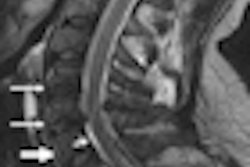Using CT for mentally compromised trauma patients to exclude cervical spine injury is a viable alternative to cervical collar immobilization and reduces unnecessary patient immobilization, according to research presented at last week's American Academy of Orthopaedic Surgeons (AAOS) annual meeting in San Francisco.
Dr. Christopher O'Boynick of St. Louis University Hospital and colleagues compared the two cervical spine clearance protocols at a level I trauma center. The team's hypothesis was that injury to the cervical spine in mentally compromised, or obtunded, trauma patients can be safely excluded with cervical CT without patient participation in a clinical exam.
"There are various algorithms across the nation for excluding cervical spine injury in the obtunded patient, but no true standardization exists," O'Boynick told session attendees. "This lack of standardization results in disjointed management of C-collar precautions, often resulting in prolonged and unnecessary immobilization."
Immobilizing patients can have negative consequences, including respiratory deterioration, skin breakdown, venous thrombosis, and delay of head and neck surgical procedures, according to O'Boynick, who cited research showing that each day spent in cervical immobilization increases the risk of bedsores by 66%.
The present study included 96 obtunded blunt trauma patients admitted to St. Louis University Hospital's level I trauma center. The patients ranged in age from 18 to 81 years. All had cervical spine CT scans that were negative for injury.
For the purposes of the study, one spine surgeon cleared the cervical spine in obtunded trauma patients using cervical CT alone at 48 to 72 hours following admission, while remaining spine surgeons awaited patient participation in a clinical exam prior to clearance. All patients cleared using CT alone underwent a clinical exam once they were awake and cooperative to rule out a missed injury. Patients were randomized to each arm based on the spine surgeon who was on-call at admission.
Forty-one patients had CT cervical spine clearance at a mean of four days (range, two to 14 days). Fifty-five patients remained immobilized until the clinical exam was performed (at an average of 15 days after admission); immobilization ranged from two to 44 days.
In patients for whom cervical spine injury had been ruled out via CT, unnecessary immobilization decreased by 11 days, and no patients had missed injury. Three patients died of injuries unrelated to their cervical spine injury: one patient in the early CT exam clearance group and two in the clinical exam group. There were no missed injuries that resulted in clinical instability.
"We found that [clearing] C-spine precautions based on a negative CT scan at admission is a viable option in trauma patients anticipated to remain obtunded for a significant amount of time," O'Boynick said.
In a related study, researchers from the Orthopaedic Trauma Institute at the University of California, San Francisco found that only 63% of all trauma centers in California have a cervical spine clearance protocol. Of these, 93% of level I, 60% of level II, and 27% of level III trauma centers had an official cervical spine clearance protocol, according to Dr. Murat Pekmezci and colleagues.
"Current cervical spine clearance guidelines recommend use of [National Emergency X-Radiography Utilization Study (NEXUS)] criteria in combination with active range of motion to clear cervical spine of asymptomatic patients, but only 50% of level I and 33% of level II centers followed this recommendation," Pekmezci concluded.



















